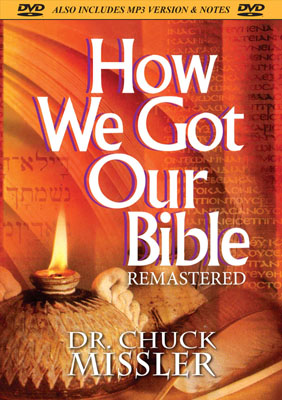We take for granted the ease with which we can make copies of documents today. Even before the revolution of our copiers and fax machines, it was the invention of Johannes Gutenberg's movable type in 1454 that ushered in the printing techniques that we also have come to take for granted today. In the ancient world, all copies had to be accomplished painstakingly by hand. Thus, the term manuscript, "manu-script."
It was quite natural that these manual methods would also be accompanied by special shortcuts, aids, and techniques to facilitate the drudgery with which the scribes were faced.
And, like all the Greeks and Romans of the period, the Christian authors and their scribes employed trained secretaries or amanuenses, trusted helpers who were well-versed in contemporary literary techniques and scribal methods. Some of them are mentioned by name in the New Testament, and Luke refers to them generally at the beginning of his Gospel.1
Notable is the importance he attributes to the eyewitnesses behind the written records, including those preceding his own.
The Hyperetai
The "ministers of the Word," were the hyperetai, the helpers. In New Testament times, this word was often used to denote attendants or servants in the synagogues, or attendants of kings and magistrates. In this case, it clearly refers to those who helped spread the good news about Jesus in writing.
The word occurs again in the sequel to Luke's Gospel, Acts 13:5. R. O. Taylor was the first to notice that John Mark, traditionally identified as the author (or Peter's amanuensis) of the oldest Gospel, is referred to as a υπηρετης hyperetes (literally, "under-rower" or subordinate rower) as a member of the missionary team organized by Paul and Barnabas in about 46 A.D. He may be so designated not just to indicate that he was merely an assistant to either of these men, but apparently to declare a title or qualification.
(Could this refer to the possibility that, by this time, he had already composed his - or Peter's - Gospel, or at least a first version of it, and that he was therefore entitled to be called a true "servant of the Word"? There are other evidences that his Gospel was in evidence even before Peter was martyred in Rome.2)
Highly qualified assistants are mentioned elsewhere in the New Testament.3 Thus, 1 Peter 5:12: "By Silvanus, a faithful brother unto you, as I suppose, I have written briefly, exhorting, and testifying that this is the true grace of God wherein ye stand." Paul's letter to the Romans, 16:22, reads: "I, Tertius, who am writing this letter, greet you in the Lord."4
These were more than ordinary scribes; they were trained professional editors, comparable to the modern-day political speech-writer. The contrast between the polished Greek of 1 Peter and the gritty, Hebraic style of 2 Peter was due to Silvanus, an experienced secretary who had already proved his worth in Paul's first and second letters to the Thessalonians.
To assuage any doubts about the final editorial authenticity, Paul would frequently add his personal signature in his own handwriting.5
It may come as a surprise to many of our readers that one of the common, virtually obligatory, qualifications among the professionals in the Greco-Roman world was that of a tachygrphos, or shorthand writer.6
Among the disciples, Matthew, a former customs official, would also likely have had a working knowledge of tachygraphy, and thus may have been able to transcribe the Sermon on the Mount verbatim, just as Tertius and others were able to transcribe Paul's more verbose utterances.7
Even in the Old Testament, in Psalm 45:1, the Hebrew, sopher mehir, the "ready writer (KJV)," or "skillful writer (NIV)," is translated in the Greek Septuagint, οξυγραφος, oxygrphos, a synonym for tachygrphos, or shorthand writer. The technical term must have been common enough among Greek-speaking Jews in the 3rd century B.C. for its use in the Septuagint to have any purpose.
Paul also mentions a technical term, membranae, a Latin word transcribed into Greek, referring to a parchment notebook.8 This was apparently a predecessor to the codex, or "book" that we know today. These were written on both sides of the sheet and were small and often pocket-sized. They were easy to handle, to skip through for reference, and to store, and thus led to the ultimate departure from the traditional scrolls.
Nomina Sacra
The tedious, painstaking tasks of record-keeping in the ancient world is difficult for us to imagine today. Thus, it is understandable that abbreviations were even more common in antiquity than today.
Even in our linguistic world, when a technical term emerges, or a complex phrase is used with substantial frequency, we indulge in abbreviations or acronyms: NATO for North Atlantic Treaty Organization; DNA for deoxyribonucleic acid; or the alphabet soup associated with governmental organizations: CIA, FBI, DOD, et al.9
One of the more significant incidences of abbreviated words, found even on the earliest samples of formalized writing, is the use of nomina sacra, holy names.10 One example is the chi-rho, Χρ, a monogram of Christ consisting of the first two letters of His name in Greek, Xριστος, Christos. Others include:
Jesus, Ιησους, Iesous = Ις
God, θεος, Theos = θς
Holy Spirit, πνευμα, Pneuma = πνα
Why are these "holy names" important? They were deliberate; their use was regular and systematic from the start. The scribes did not employ these to simply save space on a sheet of papyrus: the key point is that these "holy names" reflected a theological position.
The word "Lord," κυριος, kurios, could be applied to many different persons far removed from the Trinity; however, when abbreviated κς, it became a divine name, referring to Jesus.
In the Old Testament, we note a more subtle abbreviation in the use of the heh, for the Ruach Elohim, the Holy Spirit. An example of this occurs in Genesis 17. When the names of Abram11 and Sarai12 were changed to Abra(H)am13 and Sara(H)14 it was accomplished by simply inserting the heh into their names, marking the involvement of the Spirit of God into their lives.
The First and the Last
In numerous places in both the Old and New Testaments, God refers to Himself as "the First and the Last."15 This is also explicit in the New Testament identifiers, "Alpha and Omega," the first and last letters of the Greek alphabet.16 (In several of these references, they are unquestionably references to Jesus Christ Himself.17)
In the Old Testament, we frequently encounter the letters aleph, and the tau, the first and last letters of the Hebrew alphabet. When used with a connector-bar, a maqqeph, the two-letter prefix, at-,is used as a grammatical element to indicate a direct object. There are also instances, however, where aleph tau is used as a pronoun to indicate the second person masculine singular; a hypocatastasis ("putting down underneath"), a kind of grammatical pun: "a hidden declarative implied metaphor expressing a superlative degree of resemblance."18 For example, in Zechariah 12 we find the prophecy of the Messiah's climactic appearance to Israel:
[aleph tau]whom they have pierced...
Zechariah 12:10
The untranslated aleph tau could be translated as follows:
"... and they shall look upon me, the aleph and the tau, whom they have pierced."
...in which the aleph and the tau, the first and last letters of the Hebrew alphabet, are, thus, equivalent to the alpha and the omega in the Greek.
We also find the same untranslated letters in Genesis 1:
In the beginning God [aleph tau] created the heaven and the earth.
Genesis 1:1
This Aleph and Tau, that created the heavens and the earth, is the same Aleph and Tau whom they pierced on the wooden cross erected in Judea almost 2,000 years ago.19 And this Ultimate Nomina Sacrum is scheduled to return when He is least expected.
What About Us?
Have you ever noticed that a professional secretary never enters her boss's office without her note pad? She never enters his presence without being prepared to receive an assignment.
Do you approach the Throne Room of the Universe without a note pad nearby to jot down your own assignments or the insights you might receive? Do you enter His presence without an expectation of receiving an assignment or insight?
Pray about it. Discuss it with the King Himself.
This article was excerpted from our Briefing Package, How We Got Our Bible, and from C.P. Thiede and Matthew d'Anacona's book, The Jesus Papyrus, Wiedenfeld and Nicolson, London UK, 1996.
Notes:
- Luke 1:1, 2.
- C.P. Thiede and M. d'Ancona, The Jesus Papyrus, Wiedenfeld & Nicolson, UK, 1996, pp.170-2.
- 1 Corinthians 1:1 ("Paul ... and Sosthenes"); 2 Corinthians 1:1 ("Paul ... and Timothy"); Philippians 1:1 ("Paul and Timothy"); Colossians 1:1 ("From Paul ...and...Timothy"); 2 Thessalonians 1:1 ("Paul, Silvanus and Timothy"); and Philemon 1:1 ("From Paul ... and from our brother Timothy").
- On the strength of this declaration, Gary Burge wrote an article on Tertius entitled, "The Real Writer of Romans," Christian History, 47/XI, No. 3 (1995), p.29.
- 1 Corinthians 16:21; Galatians 6:11; Colossians 4:18; 2 Thessalonians 3:17; Philemon 19.
- E. R. Richards, The Secretary in the Letters of Paul, Tbingen, 1991, pp.26-47, 169-72 (q.v. Thiede and d'Ancona, p.240).
- E. J. Good-speed, Matthew, Apostle and Evangelist, Philadelphia, 1959, pp.16-17; and R. H. Gundry, The Use of the Old Testament in St. Matthew's Gospel, Leiden, 1967, pp.182-4; B. Orchard and H. Riley, The Order of the Synoptics, Macon GA 1987, pp.269-73 (q.v. Thiede and d'Ancona, p.240).
- 2 Timothy 4:13.
- This bandwidth compression effect, observable in any corpus of text or phonetic compilation, follows a predictable mathematical function known as Zipf's Law, or the Principle of Least Effort. See Cosmic Codes, Koinonia House, 1999, p.79-80.
- This term was coined by German scholar Ludwig Truabe, Nomina Sacra: Versuch einer Geschichte der christlichen Krzung, Munich, Germany, 1970. For the technical differences between "abbreviation," "contraction," and "suspension," see also A. H. R. E. Paap, Nomina Sacra in the Greek Papyri of the First Four Centuries A. D. - The Sources and Some Deductions, Leiden, 1959; F. Bedoldi, "I'nomina sacra' nei papiri geci veterostestmaentari precristiani," Studiea Papyrological, 13 (1974), pp.89-103, and A Pietersma, "Kyrios or Tetragram: A Renewed Quest for the Original LXX," in A. Pietersma and C. Cox, eds, De Septuaginta. Studies in Honour of John William Wevers, Mississiauga, Ont., 1984, pp.85-101; A. Millard, "Ancient Abbreviations and the Nomina Sacra," in A. Leany and E. J. Eyre, eds, An Unbroken Reed, Essays in Honour of A. f. Shore, London 1995, pp.221-6 (q.v. Thiede & d'Ancona, p.242).
- "Exalted father."
- "Princess."
- "Father, or chief, of multitude."
- "Noblewoman."
- Isaiah 41:44; 44:6; 48:12; Revelation 1:11; 22:3; et al., (below).
- Revelation 1:8; 1:17, 18; 2:8; 21:6; 22:3.
- Revelation 1:17, 18; 2:8.
- E.W. Bullinger, Figures of Speech Used in the Bible, Eyre and Spottiswoode, London, 1898, p.833. See also, Cosmic Codes, p.111-112.
- John 1:1-3.







